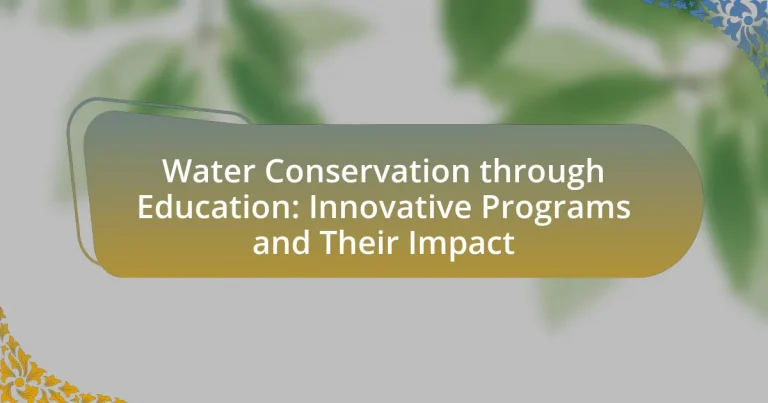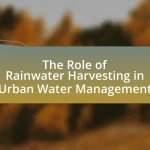Water conservation through education is a critical approach aimed at teaching individuals and communities the significance of saving water and adopting practices that minimize waste. The article explores the role of education in promoting water conservation, highlighting effective strategies such as hands-on learning, community engagement, and technology integration. It discusses the importance of water conservation in the context of increasing scarcity and environmental impacts, as well as the long-term benefits of educational programs, including behavior change and economic advantages. Additionally, successful community initiatives and school programs are examined, showcasing their effectiveness in fostering a culture of conservation and sustainable water management practices.
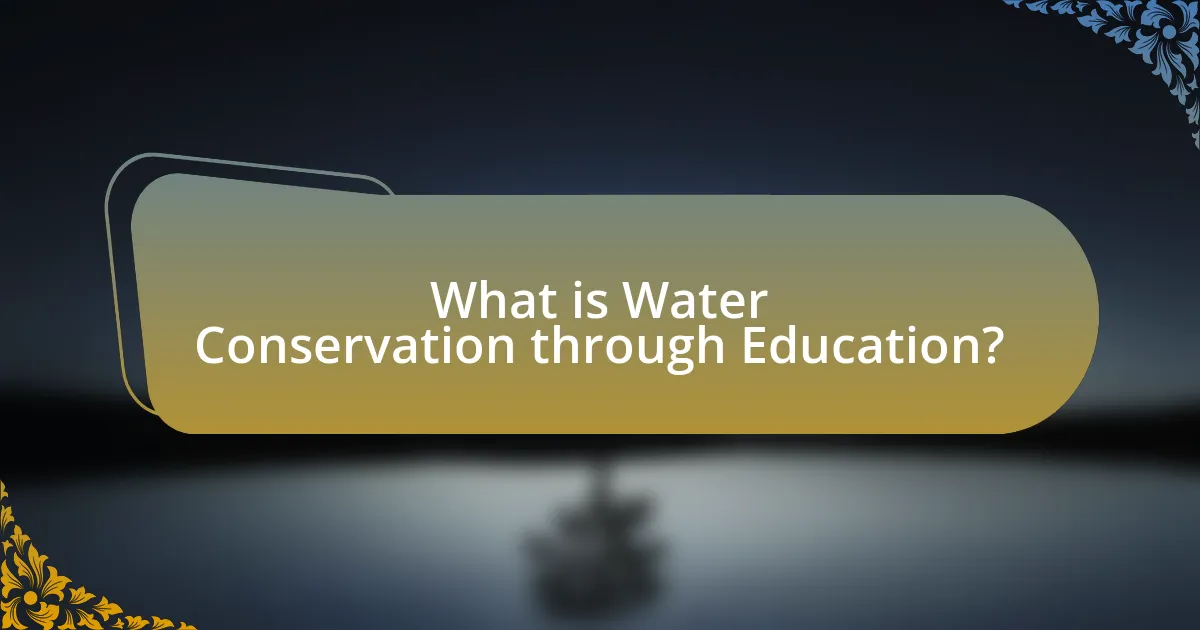
What is Water Conservation through Education?
Water conservation through education is the process of teaching individuals and communities about the importance of saving water and implementing practices that reduce water waste. This educational approach aims to raise awareness about water scarcity issues and promote sustainable water management practices. For instance, studies have shown that educational programs can lead to a significant reduction in water usage; a report by the American Water Works Association found that communities engaged in water conservation education reduced their water consumption by up to 20%.
How does education play a role in water conservation?
Education plays a crucial role in water conservation by increasing awareness and promoting responsible water usage among individuals and communities. Through educational programs, people learn about the importance of water resources, the impact of water scarcity, and practical conservation techniques. For instance, studies have shown that communities engaged in water conservation education initiatives can reduce water consumption by up to 20%. This demonstrates that informed individuals are more likely to adopt sustainable practices, such as fixing leaks, using water-efficient appliances, and implementing rainwater harvesting systems.
What are the key educational strategies for promoting water conservation?
Key educational strategies for promoting water conservation include hands-on learning experiences, community engagement initiatives, and the integration of technology in education. Hands-on learning experiences, such as school-based water audits and conservation projects, allow students to directly observe water usage and identify wasteful practices. Community engagement initiatives, like workshops and local campaigns, foster collaboration between schools and local organizations, enhancing awareness and encouraging collective action. The integration of technology, including interactive apps and online resources, provides accessible information and tools for tracking water usage, making conservation efforts more relatable and actionable. These strategies have been shown to increase knowledge and behavioral changes regarding water conservation, as evidenced by studies indicating that students involved in such programs demonstrate a significant reduction in water usage at home.
How do these strategies influence behavior change regarding water use?
Strategies such as educational programs and community engagement initiatives significantly influence behavior change regarding water use by increasing awareness and promoting sustainable practices. These strategies provide individuals with knowledge about the importance of water conservation, leading to informed decision-making and behavioral adjustments. For instance, studies have shown that participants in water conservation education programs reduced their water usage by an average of 20% after learning about the environmental impacts of excessive water consumption. This evidence indicates that targeted educational efforts can effectively alter water use behaviors, fostering a culture of conservation within communities.
Why is water conservation important in today’s context?
Water conservation is crucial in today’s context due to the increasing scarcity of freshwater resources and the impacts of climate change. As global populations rise and urbanization expands, the demand for water intensifies, leading to over-extraction and depletion of aquifers. According to the United Nations, by 2025, two-thirds of the world’s population may face water-stressed conditions, highlighting the urgent need for sustainable water management practices. Additionally, conserving water helps mitigate the effects of droughts and reduces energy consumption associated with water treatment and distribution, further emphasizing its importance in addressing environmental challenges.
What are the environmental impacts of water scarcity?
Water scarcity leads to significant environmental impacts, including habitat degradation, loss of biodiversity, and increased soil erosion. When water resources are limited, ecosystems suffer as aquatic habitats dry up, affecting species that rely on these environments for survival. For instance, the World Wildlife Fund reports that over 1 billion people live in areas where water scarcity threatens biodiversity, leading to the extinction of various plant and animal species. Additionally, reduced water availability can exacerbate soil erosion, as vegetation that stabilizes soil diminishes, resulting in increased sedimentation in waterways and further harming aquatic ecosystems.
How does water conservation contribute to sustainability efforts?
Water conservation significantly contributes to sustainability efforts by reducing the demand for freshwater resources, which helps maintain ecological balance. By implementing water-saving practices, communities can decrease water extraction from rivers, lakes, and aquifers, thereby preserving aquatic ecosystems and biodiversity. For instance, the United Nations reports that efficient water use can reduce water consumption by up to 50%, leading to less strain on natural water bodies and promoting sustainable agricultural practices. This reduction in water usage not only conserves vital resources but also minimizes energy consumption associated with water treatment and distribution, further enhancing sustainability.
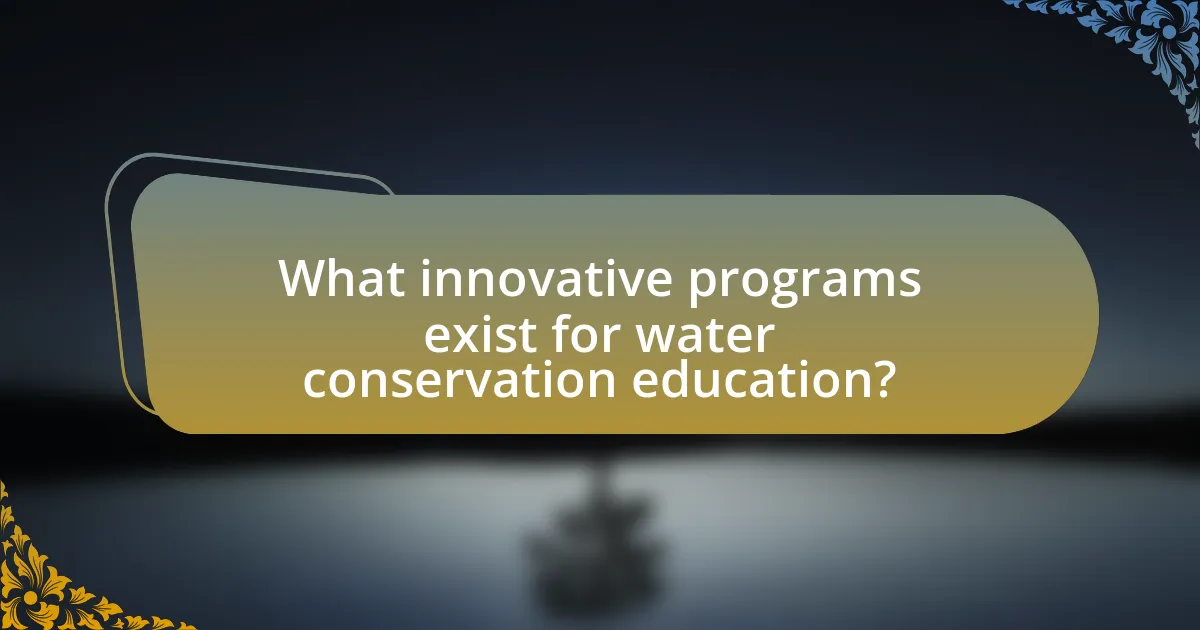
What innovative programs exist for water conservation education?
Innovative programs for water conservation education include the WaterSense program by the U.S. Environmental Protection Agency, which promotes water-efficient products and practices. This initiative has led to significant water savings, with participants reporting a reduction of over 1.5 trillion gallons of water since its inception in 2006. Another example is the “Save Water, Save Life” campaign, which engages communities through workshops and school programs, emphasizing practical water-saving techniques. Additionally, the “Water Conservation Challenge” in schools encourages students to develop projects that promote water-saving behaviors, fostering a culture of conservation among youth. These programs demonstrate effective strategies for raising awareness and promoting sustainable water use.
How do community-based programs promote water conservation?
Community-based programs promote water conservation by engaging local populations in sustainable practices and education initiatives. These programs often involve workshops, community meetings, and hands-on activities that teach residents about efficient water use, the importance of preserving local water sources, and techniques for reducing water waste. For example, a study by the American Water Works Association found that community engagement can lead to a 20% reduction in water usage in participating households. By fostering a sense of ownership and responsibility towards water resources, these programs effectively encourage behavioral changes that contribute to long-term conservation efforts.
What are some successful examples of community initiatives?
Successful examples of community initiatives in water conservation include the “WaterSmart” program in California, which educates residents on efficient water use and has led to a 20% reduction in water consumption. Another example is the “Rainwater Harvesting” initiative in Australia, where communities are encouraged to collect rainwater for irrigation, resulting in significant water savings and increased awareness of sustainable practices. Additionally, the “Green Schools” program in the United States promotes water conservation education among students, leading to a measurable decrease in school water usage by up to 30%. These initiatives demonstrate effective community engagement and tangible impacts on water conservation efforts.
How do these initiatives engage local populations?
These initiatives engage local populations by incorporating community-driven education programs that promote water conservation practices. For example, workshops and hands-on activities are organized to teach residents about sustainable water use, which fosters a sense of ownership and responsibility towards local water resources. Research indicates that community participation in educational initiatives significantly increases awareness and behavioral changes regarding water conservation, as seen in programs implemented in various regions where local feedback shapes the curriculum and outreach strategies.
What role do schools play in water conservation education?
Schools play a crucial role in water conservation education by integrating environmental awareness into their curricula. They provide students with knowledge about the importance of water conservation, teaching practical skills such as reducing water waste and understanding the water cycle. Research indicates that educational programs in schools can significantly increase students’ awareness and engagement in water conservation efforts, leading to behavioral changes that promote sustainable practices. For instance, a study by the University of California found that students who participated in water conservation education programs reduced their household water usage by an average of 20%. This demonstrates that schools are instrumental in fostering a culture of conservation among young individuals, equipping them with the knowledge and motivation to protect water resources.
What programs are implemented in schools to teach water conservation?
Schools implement various programs to teach water conservation, including hands-on activities, curriculum integration, and community partnerships. Programs like Project WET (Water Education for Teachers) provide educators with resources to teach students about water cycles, conservation techniques, and the importance of water sustainability. Additionally, many schools engage in local initiatives, such as water audits and rainwater harvesting projects, which allow students to apply their knowledge practically. Research indicates that these educational programs significantly increase students’ awareness and responsible behaviors regarding water usage, leading to a measurable reduction in water waste in participating communities.
How effective are school programs in changing student behavior?
School programs are highly effective in changing student behavior, particularly in the context of water conservation education. Research indicates that programs focused on environmental education, such as those promoting water conservation, can lead to significant behavioral changes among students. For instance, a study published in the Journal of Environmental Education found that students who participated in water conservation programs demonstrated a 30% increase in water-saving behaviors at home compared to those who did not participate. This effectiveness is attributed to hands-on learning experiences and the integration of practical applications, which reinforce the importance of conservation practices.
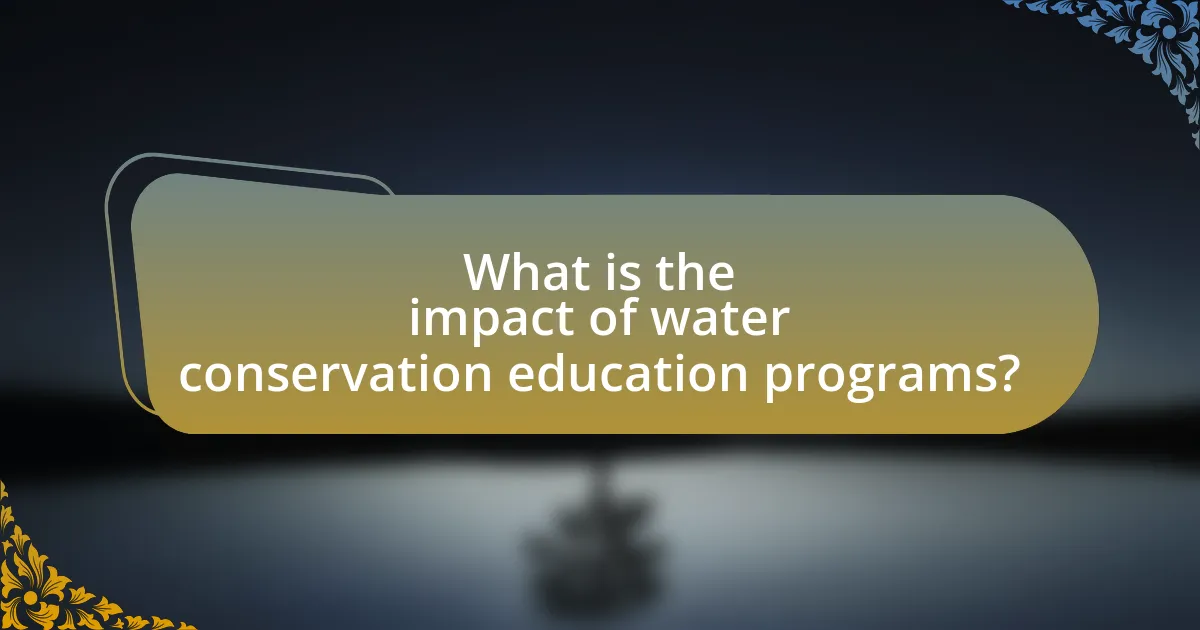
What is the impact of water conservation education programs?
Water conservation education programs significantly reduce water consumption and promote sustainable practices among communities. These programs raise awareness about the importance of water conservation, leading to behavioral changes that result in lower water usage. For instance, a study by the American Water Works Association found that communities engaged in water conservation education initiatives reduced their water use by an average of 10-20%. Additionally, these programs often include practical strategies for individuals and businesses, such as efficient irrigation techniques and water-saving technologies, which further enhance their effectiveness in conserving water resources.
How do these programs measure their success?
These programs measure their success through quantifiable metrics such as water savings, participant engagement levels, and behavioral changes in water usage. For instance, programs often track the reduction in water consumption in participating households or communities, which can be quantified through utility data before and after program implementation. Additionally, surveys and feedback mechanisms assess participant knowledge and attitudes towards water conservation, providing insights into educational effectiveness. Studies have shown that programs that incorporate pre- and post-assessments of knowledge can demonstrate significant increases in awareness and behavioral shifts, thus validating their impact on water conservation efforts.
What metrics are used to evaluate the effectiveness of educational initiatives?
Metrics used to evaluate the effectiveness of educational initiatives include student engagement levels, knowledge retention rates, behavioral changes, and program reach. Student engagement levels can be measured through attendance and participation rates, indicating how actively students are involved in the educational process. Knowledge retention rates assess how much information students retain over time, often evaluated through pre- and post-assessments. Behavioral changes reflect the practical application of learned concepts, such as increased water conservation practices among participants. Program reach measures the number of individuals or communities impacted by the initiative, providing insight into the initiative’s overall influence. These metrics collectively provide a comprehensive evaluation of educational initiatives’ effectiveness in promoting water conservation.
How do participant surveys contribute to understanding program impact?
Participant surveys provide critical insights into the effectiveness of water conservation education programs by capturing participants’ perceptions, behaviors, and knowledge changes. These surveys allow program evaluators to quantify the impact of educational initiatives, revealing how well participants understand water conservation principles and whether their behaviors have shifted as a result of the program. For instance, a study by the Water Research Foundation found that post-program surveys indicated a 30% increase in participants’ water-saving behaviors, demonstrating a direct correlation between educational efforts and behavioral change. This data not only validates the program’s effectiveness but also informs future improvements and adaptations to enhance educational strategies.
What long-term benefits arise from water conservation education?
Water conservation education leads to sustainable water management practices, which result in long-term benefits such as reduced water scarcity, improved ecosystem health, and enhanced community resilience. By educating individuals and communities about the importance of conserving water, they are more likely to adopt practices that minimize waste, such as using water-efficient appliances and implementing rainwater harvesting systems. Research indicates that communities engaged in water conservation education programs can reduce water usage by up to 30%, significantly alleviating pressure on local water supplies. Furthermore, these educational initiatives foster a culture of environmental stewardship, encouraging future generations to prioritize sustainable practices, thereby ensuring the longevity of water resources.
How does education influence future generations’ water usage habits?
Education significantly influences future generations’ water usage habits by instilling awareness and knowledge about water conservation practices. Programs that educate individuals about the importance of sustainable water management lead to behavioral changes, such as reduced water waste and increased efficiency in usage. For instance, studies have shown that children who participate in water conservation education programs are more likely to adopt water-saving behaviors at home, such as shorter showers and fixing leaks. This is supported by research from the University of California, which found that educational interventions can lead to a 20% reduction in household water use among participants. Thus, education serves as a critical tool in shaping responsible water usage habits for future generations.
What economic benefits can result from effective water conservation practices?
Effective water conservation practices can lead to significant economic benefits, including reduced utility costs and increased agricultural productivity. By implementing water-saving technologies and practices, households can lower their water bills, with studies showing potential savings of up to 30% on monthly water expenses. Additionally, in agriculture, efficient water use can enhance crop yields and reduce irrigation costs, contributing to a more sustainable and profitable farming sector. For instance, the California Department of Water Resources reported that investments in water conservation can yield a return of $2 to $4 for every dollar spent, highlighting the financial advantages of such practices.
What are best practices for implementing water conservation education programs?
Best practices for implementing water conservation education programs include engaging the community through interactive workshops and hands-on activities. These methods foster a deeper understanding of water issues and encourage behavioral changes. Research indicates that programs incorporating local water issues and solutions, such as the “WaterSmart” initiative, have shown a 20% reduction in water usage among participants. Additionally, utilizing diverse communication channels, including social media and local events, enhances outreach and effectiveness. Programs that involve partnerships with schools and local organizations also increase participation and sustainability, as evidenced by the success of the “Save Water” campaign in various municipalities.
How can organizations effectively engage stakeholders in these programs?
Organizations can effectively engage stakeholders in water conservation programs by implementing collaborative strategies that foster participation and ownership. Engaging stakeholders through workshops, community meetings, and educational campaigns allows organizations to gather input, share knowledge, and build trust. For instance, a study by the World Resources Institute highlights that involving local communities in decision-making processes significantly increases program success rates, as stakeholders feel more invested in the outcomes. Additionally, utilizing social media platforms for outreach can enhance communication and awareness, reaching a broader audience and encouraging active involvement.
What resources are available for developing educational materials on water conservation?
Resources available for developing educational materials on water conservation include government agencies, non-profit organizations, and online platforms. The U.S. Environmental Protection Agency (EPA) provides comprehensive guidelines and educational resources focused on water conservation practices. Additionally, organizations like the Water Education Foundation offer lesson plans and activities tailored for various educational levels. Online platforms such as the National Geographic Education website also feature resources that promote awareness and understanding of water conservation issues. These resources are validated by their widespread use in educational settings and their alignment with national standards for environmental education.
